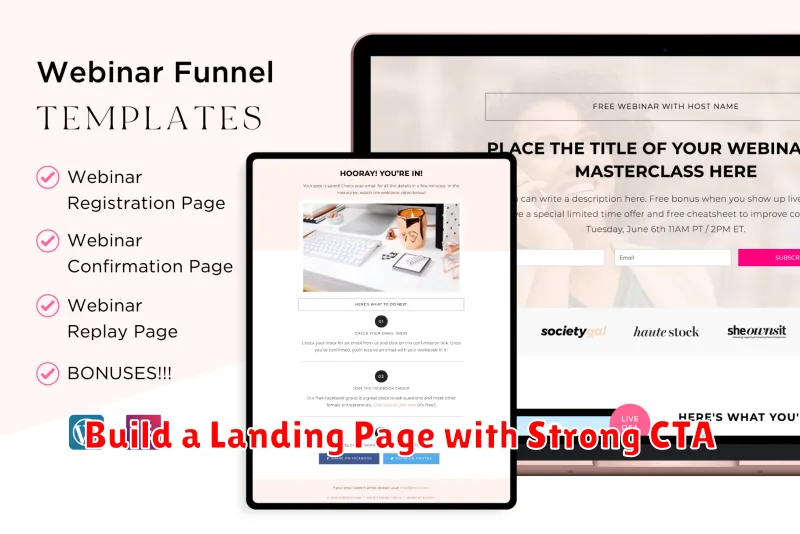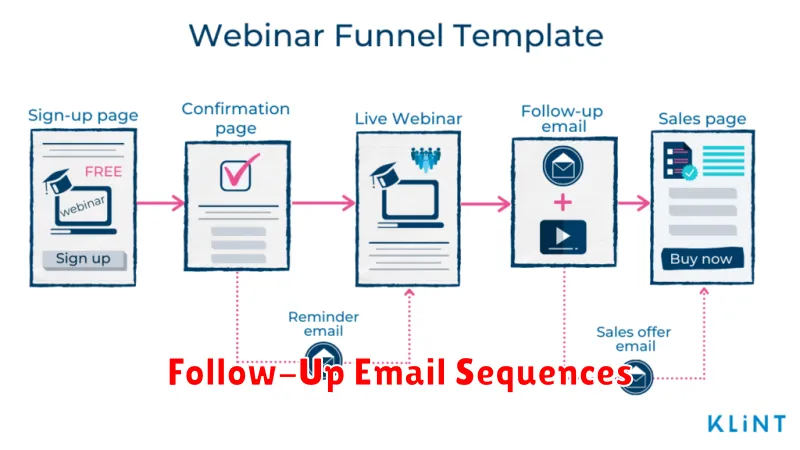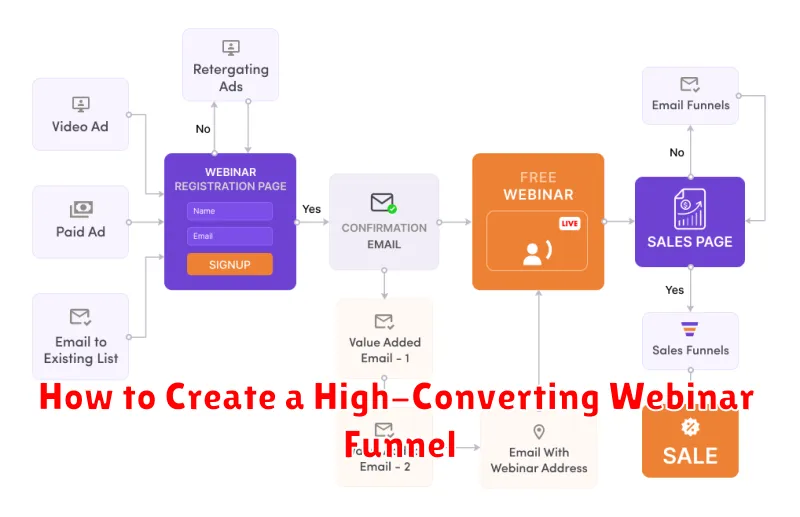Are you ready to unlock the power of webinars and transform your audience into paying customers? This comprehensive guide will delve into the intricacies of crafting a high-converting webinar funnel, designed to maximize registrations and ultimately boost your sales. Learn how to strategically implement every stage of the funnel, from attracting your ideal audience to nurturing leads and securing conversions. We will cover the essential elements required for success, including compelling webinar topics, effective landing pages, and strategic email marketing sequences. Whether you’re a seasoned marketer or just starting out, mastering the art of the high-converting webinar funnel is a game-changer for any business seeking exponential growth.
This article will provide a step-by-step approach to building a webinar funnel that converts. We will explore the key stages of the funnel: attracting attendees with targeted advertising and engaging content, capturing leads with persuasive registration pages, delivering a high-value webinar presentation, and following up with effective post-webinar strategies to nurture leads and drive sales. By understanding the nuances of each stage and implementing the proven techniques outlined in this guide, you can create a high-converting webinar funnel that generates significant results and propels your business forward. Prepare to transform your webinar strategy and witness the remarkable impact a well-crafted funnel can have on your bottom line.
Plan Your Webinar Topic and Goal
The foundation of a successful webinar lies in a well-defined topic and a clear goal. Choosing the right topic is crucial for attracting your target audience and ensuring high engagement. Consider what problems your audience faces and how your expertise can provide solutions. What knowledge gaps can you fill?
Your webinar topic should be specific and actionable. Instead of a broad topic like “Social Media Marketing,” consider something more focused, such as “5 Strategies to Increase Engagement on Instagram.” This specificity helps attract a more qualified audience.
Equally important is defining your webinar’s goal. What do you want attendees to do after the webinar? Do you want them to sign up for a free trial, download a resource, or schedule a consultation? A measurable goal is essential for tracking the effectiveness of your webinar and optimizing your funnel.
Aligning your topic and goal ensures a cohesive and effective webinar that delivers value to your audience and drives conversions.
Choose the Right Webinar Platform
Selecting the right webinar platform is crucial for a successful webinar funnel. The platform should align with your needs and budget, offering the necessary features for a seamless experience.
Consider these key factors when choosing a platform:
- Capacity: How many attendees do you anticipate? Choose a platform that can comfortably handle your expected audience size.
- Interactive Features: Look for features like live chat, Q&A, polls, and surveys to engage your audience and gather valuable feedback.
- Recording Capabilities: Ensure the platform allows for recording, enabling you to repurpose the webinar content later.
- Integrations: Check if the platform integrates with your existing marketing tools, such as your email marketing service or CRM.
- Pricing: Webinar platforms offer various pricing plans. Select one that fits within your budget while providing the essential features.
Evaluating these aspects will help you identify the ideal platform for your high-converting webinar funnel.
Build a Landing Page with Strong CTA

A dedicated landing page is crucial for capturing webinar registrations. This page should be distinct from your website’s general pages and focused solely on the webinar.
Headline: Start with a compelling headline that clearly communicates the webinar’s value proposition. What problem will attendees solve by participating?
Benefits: Highlight the key benefits attendees will gain. Use bullet points or a short list to make this information easily digestible.
Webinar Details: Include essential information like date, time, and speaker(s). If offering a replay, mention this as well.
Call to Action (CTA): A strong CTA is essential. Use action-oriented language like “Register Now,” “Save Your Spot,” or “Join Us.” Make the button visually prominent.
Set Up Email Reminders
Email reminders are crucial for boosting webinar attendance rates. A well-timed sequence of reminders keeps registrants engaged and reduces no-shows.
Implement a series of at least three email reminders:
- Confirmation Email: Sent immediately after registration. Thank the registrant and reiterate the webinar details.
- Reminder Email 1: Sent 24-48 hours before the webinar. Reinforce the value proposition and create excitement.
- Reminder Email 2: Sent 1-2 hours before the webinar as a final nudge. Include a direct link to join the webinar room.
Consider an additional reminder one hour after the webinar starts for those who didn’t attend. This reminder can include a link to the recording.
Engage Attendees Live
Live engagement is crucial for webinar success. It transforms a passive presentation into an interactive experience, boosting attendee satisfaction and increasing conversion rates. Interaction keeps attendees focused and reinforces the value of your content.
Implement these strategies to maximize engagement:
- Q&A Sessions: Dedicate time for live questions. This addresses attendee concerns directly and provides valuable insights into their needs.
- Polls and Surveys: Use these tools to gather real-time feedback and understand audience perspectives. This also provides valuable data for future marketing efforts.
- Interactive Quizzes: Test attendee knowledge and make learning fun. This can also be used to segment your audience based on understanding.
- Live Chat: Encourage attendees to communicate with each other and with you throughout the webinar. This fosters a sense of community.
By actively engaging your audience, you create a more dynamic and memorable experience, leading to stronger connections and higher conversions.
Follow-Up Email Sequences

Follow-up email sequences are crucial for nurturing leads after your webinar. These automated emails help maintain engagement and guide attendees towards conversion. A well-structured sequence can significantly improve your webinar’s overall effectiveness.
Consider these key elements when crafting your follow-up sequence:
- Thank You Email: Immediately after the webinar, send a thank you email expressing gratitude for their attendance. Include a replay link and any promised resources.
- Value-Driven Emails: Provide additional valuable content related to the webinar topic. This reinforces your expertise and builds trust.
- Offer Emails: Introduce your product or service as a solution to the problems discussed in the webinar. Highlight its benefits and include a clear call to action.
- Reminder Emails: If you have a limited-time offer, send reminder emails to create urgency and encourage conversions.
By strategically segmenting your audience and tailoring your email content, you can personalize the follow-up experience and increase conversion rates.
Convert Leads into Customers
This stage focuses on turning your qualified webinar attendees into paying customers. Nurturing is key here. Don’t expect immediate conversions. Instead, focus on building relationships and providing value.
Immediately following the webinar, send a follow-up email. This email should thank attendees for their time and provide a recording of the webinar (if applicable). It should also include a clear call to action, such as a special offer or a link to your sales page.
Continue engaging with attendees through a series of targeted emails. These emails can offer additional resources, case studies, or testimonials. The goal is to build trust and demonstrate the value of your product or service.
Consider implementing a limited-time offer to create a sense of urgency and encourage conversions. This could be a discount, bonus, or exclusive access to a particular resource.

